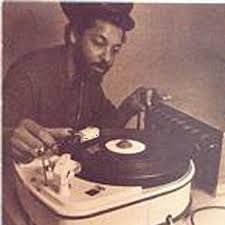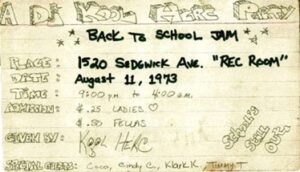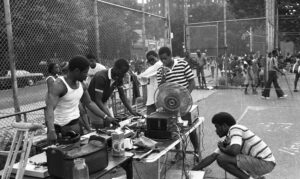
DJ Kool Herc
Hip hop is a form of musical expression and artistic culture that originated in African-American and Latino communities during the 1970s in New York City, specifically the Bronx. DJ Afrika Bambaataa outlined the four pillars of hip hop culture: MCing, DJing, breaking and graffiti writing. Other elements include beatboxing.
Since its emergence from the South Bronx, hip hop culture has spread around the world. Hip hop music first emerged with disc jockeys creating rhythmic beats by looping breaks (small portions of songs emphasizing a percussive pattern) on two turntables, more commonly referred to as sampling. This was later accompanied by “rap”, a rhythmic style of chanting or poetry presented in 16 bar measures or time frames, and beatboxing, a vocal technique mainly used to imitate percussive elements of the music and various technical effects of hip-hop DJ’s. An original form of dancing and particular styles of dress arose among fans of this new music. These elements experienced considerable refinement and development over the course of the history of the culture.

Hip hop originated, by most accounts, in the late 60s with Clive Campbell, also known as DJ Kool Herc. In fact, Herc is the person that brought the first hip-hop music to the Bronx in the 1970s. He primarily played hard funk and disco records on turntables but is most famous for inventing the “break” in hip-hop–the heavily percussive, drum-beat section of a song. Herc most famously prolonged this section of a record by replaying it using two turntables to make a beat. When the discos and nightclubs began to close due to economic collapse, Block Parties in the streets of New York. DJ’s like Kool Herc was among the first to play modern funk and soul records on two turntables in front of crowds of people. The rise of block parties also brought breakdancing and “b-boying” into hip-hop culture.

Kool Herc setting up a block party at the Sedgwick apartments
Jamaican born DJ “Kool Herc” is credited as being highly influential in the pioneering stage of hip hop music, in the Bronx, after moving to New York at the age of thirteen. Herc created the blueprint for hip-hop music and culture by building upon the Jamaican tradition of toasting—impromptu, boastful poetry and speech over music—which he witnessed as a youth in Jamaica.
Herc and other DJs would tap into the power lines to connect their equipment and perform at venues such as public basketball courts and at 1520 Sedgwick Avenue, Bronx, New York, a historic building is thought of by many as the place “where hip-hop was born”. Their equipment was composed of numerous speakers, turntables, and one or more microphones. By using this technique DJs could create a variety of music. (Via Wikipedia)
“The building, at 1520 Sedgwick Avenue, would be just another one of the flurry of Mitchell-Lama buildings that have changed hands over the past few years, were it not for its community room. It was there, in 1973, that Clive Campbell, known as D.J. Kool Herc, started turning the tables at community parties, producing a sound, a rhythm and a style that spilled out into the nearby parks and streets and, later, to the world. Mr. Campbell was living in the building at the time with his sister, Cindy Campbell.” Via NY Times
“After a long struggle, ownership of a Bronx building known as the birthplace of hip-hop, which had fallen into neglect and foreclosure, was taken over on Monday by a group that specializes in preserving working-class housing…
Because of its hip-hop reputation, the building in 2007 was deemed eligible for listing on the National Register of Historic Places, though its owner declined to do so because that would put restrictions on its maintenance. The new owner plans to pursue a listing.
Representative José E. Serrano, who had lobbied with building residents in a failed attempt to buy the building in 2007, said he was “cautiously optimistic” about the auction.
“The new owners have committed to preserving the building as affordable housing, and to engage in efforts to better recognize the building’s historic status as the birthplace of hip-hop,” he said. “If taken, all of these steps will help revitalize and properly recognize this historic location.” (Via NY Times)
Many questions remain for those interested in taking the challenge to research the origins of Hip Hop:
- Do you agree with this description of the history of Hip Hop?
- Were there other places or specific locations that were important to the development of Hip Hop?
- Were there other people who could claim to be the originators of the art form?
Take the challenge to research, refine, and submit a new version of this entry or new entries for new locations.
